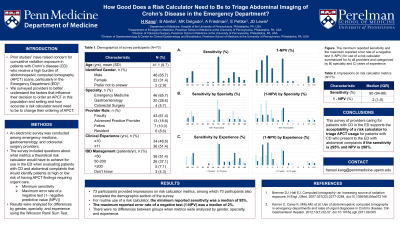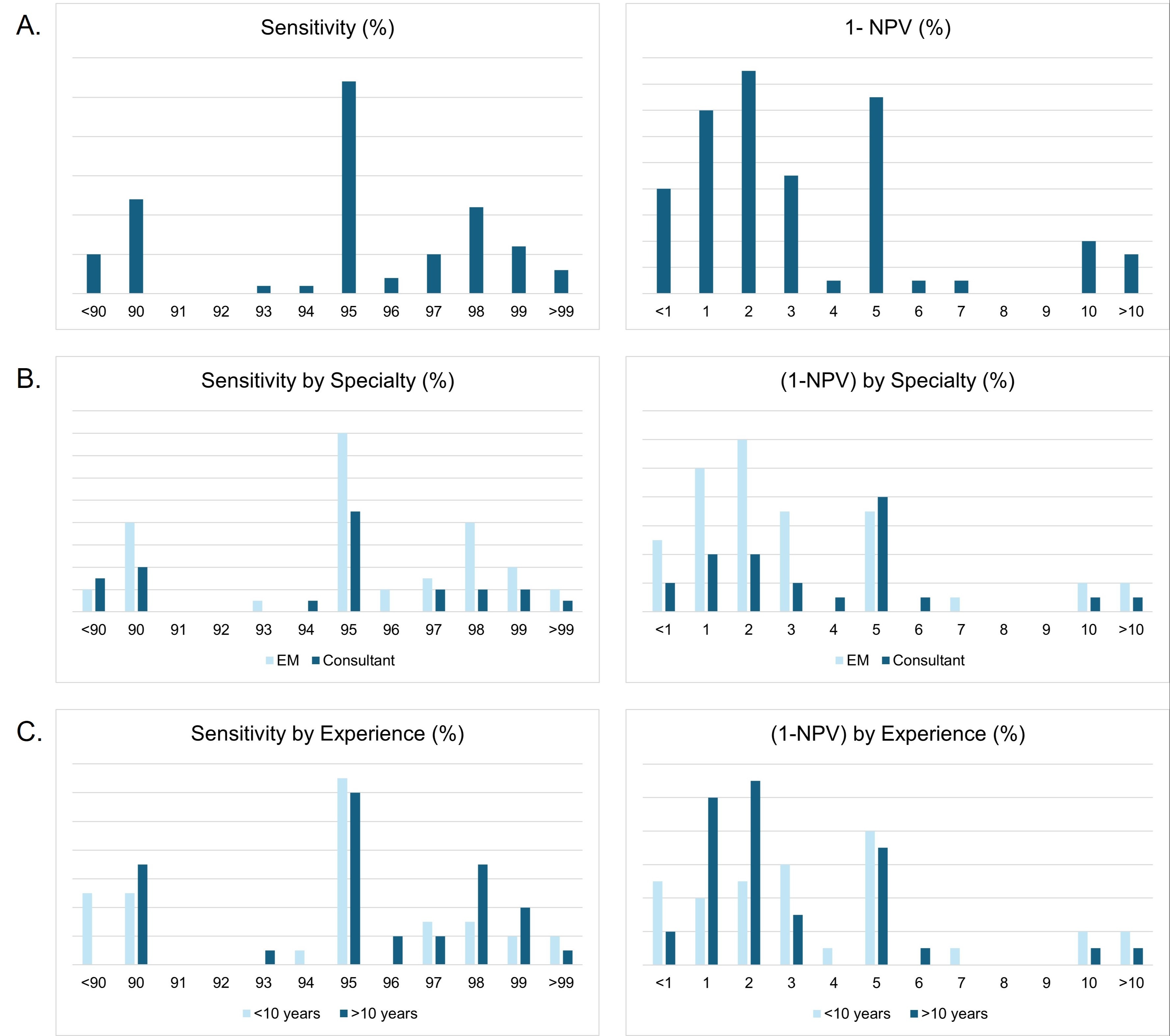Sunday Poster Session
Category: IBD
P0888 - How Good Does a Risk Calculator Need to Be to Triage Abdominal Imaging of Crohn’s Disease in the Emergency Department?
Sunday, October 27, 2024
3:30 PM - 7:00 PM ET
Location: Exhibit Hall E


Hansol Kang, MD
University of Pennsylvania Health System
Philadelphia, PA
Presenting Author(s)
Hansol Kang, MD1, Benjamin Abella, MD, MPhil2, Ari Friedman, MD, PhD2, Erica Pettke, MD, MPH2, Kit Delgado, MD, MS2, James Lewis, MD, MSCE2
1University of Pennsylvania Health System, Philadelphia, PA; 2Perelman School of Medicine at the University of Pennsylvania, Philadelphia, PA
Introduction: Prior studies have raised concern for cumulative radiation exposure in patients with Crohn’s disease (CD) who receive a high burden of abdominopelvic computed tomography (APCT) scans, particularly in the Emergency Department (ED). To improve the appropriate use of APCT in the ED, risk calculators have been developed to stratify the risk for urgent findings and elucidate the need for imaging. Unfortunately, these tools have met barriers to utilization and applicability. In this study, we surveyed providers to better understand the factors that influence their decision to order an APCT in this population and setting and how accurate a risk calculator would need to be to change their ordering of APCT.
Methods: An electronic survey was conducted among emergency medicine, gastroenterology, and colorectal surgery providers. The survey included questions about a theoretical risk calculator for use in the ED when evaluating patients with CD and abdominal complaints. The risk calculator would identify patients at high or low risk of having APCT findings requiring urgent care. Participants reported the minimum sensitivity and maximum error rate of a negative test (1- negative predictive value (NPV)) that a risk calculator must achieve for it to be routinely used when evaluating patients with CD who present to the ED with abdominal complaints. Results were analyzed for differences by gender, specialty, and experience using the Wilcoxon Rank Sum Test.
Results: 73 participants provided impressions on risk calculator metrics, among which 70 participants also completed the demographic section of the survey. The mean age of participants was 41.1 years (SD 9.7) and the majority of participants were emergency medicine providers (n=46, 65.7%) followed by gastroenterology providers (n=20, 28.6%), and colorectal surgery providers (n=4, 5.7%). The minimum reported sensitivity for use of a risk calculator was a median of 95% (IQR 94-98%). The maximum reported error rate of a negative test (1-NPV) was a median of 2% (IQR 1-5%). There were no differences between groups when metrics were analyzed by gender, specialty, and experience.
Discussion: This survey of providers caring for patients with CD in the ED supports the acceptability of a risk calculator to triage APCT usage for patients with CD who present to the ED with abdominal complaints if the sensitivity is ≥95% and NPV is ≥98%.

Note: The table for this abstract can be viewed in the ePoster Gallery section of the ACG 2024 ePoster Site or in The American Journal of Gastroenterology's abstract supplement issue, both of which will be available starting October 27, 2024.
Disclosures:
Hansol Kang, MD1, Benjamin Abella, MD, MPhil2, Ari Friedman, MD, PhD2, Erica Pettke, MD, MPH2, Kit Delgado, MD, MS2, James Lewis, MD, MSCE2. P0888 - How Good Does a Risk Calculator Need to Be to Triage Abdominal Imaging of Crohn’s Disease in the Emergency Department?, ACG 2024 Annual Scientific Meeting Abstracts. Philadelphia, PA: American College of Gastroenterology.
1University of Pennsylvania Health System, Philadelphia, PA; 2Perelman School of Medicine at the University of Pennsylvania, Philadelphia, PA
Introduction: Prior studies have raised concern for cumulative radiation exposure in patients with Crohn’s disease (CD) who receive a high burden of abdominopelvic computed tomography (APCT) scans, particularly in the Emergency Department (ED). To improve the appropriate use of APCT in the ED, risk calculators have been developed to stratify the risk for urgent findings and elucidate the need for imaging. Unfortunately, these tools have met barriers to utilization and applicability. In this study, we surveyed providers to better understand the factors that influence their decision to order an APCT in this population and setting and how accurate a risk calculator would need to be to change their ordering of APCT.
Methods: An electronic survey was conducted among emergency medicine, gastroenterology, and colorectal surgery providers. The survey included questions about a theoretical risk calculator for use in the ED when evaluating patients with CD and abdominal complaints. The risk calculator would identify patients at high or low risk of having APCT findings requiring urgent care. Participants reported the minimum sensitivity and maximum error rate of a negative test (1- negative predictive value (NPV)) that a risk calculator must achieve for it to be routinely used when evaluating patients with CD who present to the ED with abdominal complaints. Results were analyzed for differences by gender, specialty, and experience using the Wilcoxon Rank Sum Test.
Results: 73 participants provided impressions on risk calculator metrics, among which 70 participants also completed the demographic section of the survey. The mean age of participants was 41.1 years (SD 9.7) and the majority of participants were emergency medicine providers (n=46, 65.7%) followed by gastroenterology providers (n=20, 28.6%), and colorectal surgery providers (n=4, 5.7%). The minimum reported sensitivity for use of a risk calculator was a median of 95% (IQR 94-98%). The maximum reported error rate of a negative test (1-NPV) was a median of 2% (IQR 1-5%). There were no differences between groups when metrics were analyzed by gender, specialty, and experience.
Discussion: This survey of providers caring for patients with CD in the ED supports the acceptability of a risk calculator to triage APCT usage for patients with CD who present to the ED with abdominal complaints if the sensitivity is ≥95% and NPV is ≥98%.

Figure: The minimum reported sensitivity and the maximum reported error rate of a negative test (1-NPV) for use of a risk calculator to triage APCT usage in patients with CD and abdominal complaints in the ED summarized for A) all providers and categorized by B) specialty and C) years of experience.
Note: The table for this abstract can be viewed in the ePoster Gallery section of the ACG 2024 ePoster Site or in The American Journal of Gastroenterology's abstract supplement issue, both of which will be available starting October 27, 2024.
Disclosures:
Hansol Kang indicated no relevant financial relationships.
Benjamin Abella indicated no relevant financial relationships.
Ari Friedman indicated no relevant financial relationships.
Erica Pettke indicated no relevant financial relationships.
Kit Delgado indicated no relevant financial relationships.
James Lewis: AbbVie – Consultant, Grant/Research Support. Amgen – Advisory Committee/Board Member. Arena Pharmaceuticals – Advisory Committee/Board Member. Bridge Biotherapeutics – Consultant. Celgene/BMS – Consultant. Entasis Therapeutics – Consultant. Galapagos – Advisory Committee/Board Member. Gilead – Advisory Committee/Board Member. Janssen – Consultant, Grant/Research Support. Merck – Consultant. Nestle Health Science – Grant/Research Support. Pfizer – Advisory Committee/Board Member. Protagonist Therapeutics – Advisory Committee/Board Member. Sanofi – Advisory Committee/Board Member. Scipher Medicine – Consultant. Takeda – Grant/Research Support.
Hansol Kang, MD1, Benjamin Abella, MD, MPhil2, Ari Friedman, MD, PhD2, Erica Pettke, MD, MPH2, Kit Delgado, MD, MS2, James Lewis, MD, MSCE2. P0888 - How Good Does a Risk Calculator Need to Be to Triage Abdominal Imaging of Crohn’s Disease in the Emergency Department?, ACG 2024 Annual Scientific Meeting Abstracts. Philadelphia, PA: American College of Gastroenterology.
